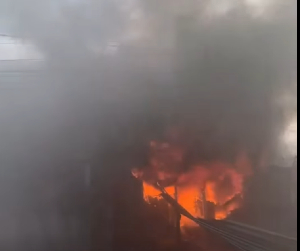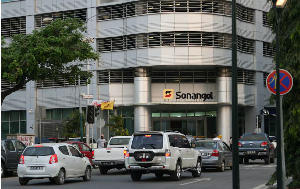Health post so close, yet health care many miles away. Scattered units with no central point, a make-shift surgical theatre where women in labour who need to undergo caesarean section are operated on simultaneously with other patients undergoing other surgical procedures.
Call it the health facility to have received the most promises of retooling and redevelopment in successive government’s statements and you would not be far from wrong.
The cry of its management, workers, civil society groups, non-governmental organisations (NGOs) and, most importantly, patients, could be described as the most reported news item in the Tema Metropolis.
Isn’t it about time Tema got its fair share of the many health intervention projects being undertaken by the government nationwide?
Perhaps, President Mahama’s latest promise captured in the Daily Graphic of Thursday, June 23, headlined, “Tema to regain lost glory” which reiterated that the hospital would be upgraded might be the magic wand that could change the fortunes of the hospital.
Imagine a patient in hospital who is seeking treatment but sleeps on wooden benches and on the bare floor. Such situations, including wailing women in labour pacing the corridors, while others cup their chin in their palms in deep thought, are enough to give you goose pimples.
Many patients have come to accept their fate, since they lack the financial capacity to seek care at private facilities in the metropolis.
“If I have money to be delivered of my baby at a private facility, why would I come and queue here with other pregnant women who equally have no beds to lie on, but are made to endure labour pains sitting on chairs overnight? Ms Cynthia Annan complained bitterly when the Daily Graphic visited the maternity unit on Wednesday, June 22, 2016 where she had queued the previous night to be delivered of her baby.
“I have been scheduled to undergo caesarean delivery but I have been waiting since last night (Tuesday), since the delivery theatre was occupied, and I am experiencing severe back pain coupled with the labour pains,” Ms Annan said amid tears.
The above sums up the situation of the 294-bed capacity hospital situated in a highly industrial city close to three major highways, namely Accra-Tema, Tema-Aflao and Tema-Akosombo roads.
The facility is a major referral health centre for private and government facilities in the Tema Metropolis with its catchment area extending to Afienya, Dawhenya and Prampram in the Dangme East and West districts. It has an estimated population of 900,000 and reels under severe challenges.
It also receives referral cases from the Sogakope and Battor Catholic hospitals in the Volta Region.
It is public knowledge that infrastructure at the facility is poor, since the entire hospital could be described as being housed in a make-shift structure which was handed over to the Ghanaian government in 1967 by Sir William Halcrow and Partners who developed the Tema Port.
The company used the facility as a clinic for the treatment of injured construction workers and engineers who worked on the habour project from 1954-1967.
The facility has 21 various units. Notable among them are the internal medicine and intensive care unit, general surgery, physiotherapy, specialist clinics such as sickle cell, diabetic, among others. It has 40 doctors, 49 house officers, 430 nurses, interns and other general staff. The facility recorded an outpatient (OPD) attendance of 106,101 in 2015.
Some 7,000 deliveries and 2,035 caesarean sections were also performed in the year under review, with some 41 maternal deaths also being recorded.
The congestion at the Department of Obstetrics and Gynaecology had in most cases seen women with serious health complications made to wait for long hours before they are sent to the theatre.
In most cases, about four to five women are made to share a single bed with the new-borns, a situation which could have health implications for the children and their mothers.
According to the Medical Director of the hospital, Dr Kwabena Opoku Adusei, the significance of these abandoned projects meant some cases that could be operated on at the facility had to be referred to the Korle Bu Teaching Hospital and other facilities which were also congested.
He told the Daily Graphic that the quality of patient care was not as management would expect.
“The degree of destruction is such that it is beyond the use of our meagre internally generated funds (IGF),” Dr Adusei pointed out.
Some rehabilitation projects commenced at the hospital in 2007 for the general theatre but these have not seen the light of day, leaving the structures at the mercy of the weather, with the roofing sheets posing danger to patients and patrons of the hospital.
The maternity block, which was awarded on contract some seven years ago, has also been abandoned.
The infrastructure challenges have led to unnecessary deaths being recorded at the facility.
A widower, Mr Delali Amexo, who lost his wife at the facility on April 24, 2015, is among many who have lost hope in the ability of the hospsital to save lives. His wife’s death could have been avoided with the help of a defibrillation device, an apparatus that could have applied electric shock to the heart of a patient suffering cardiac arrest.
To him, if you are sick and want to hasten your death, visit the Tema Genera Hospital and your wish would materialise.
A mortuary for 1,000 bodies undertaken by the Tema Metropolitan Assembly (TMA) to replace the dilapidated one at the facility has also been abandoned.
The beautifully painted edifice with no mortuary refrigeration system and cold-room facilities has been taken over by weeds.
The hospital has continued to rely on philanthropic gestures for the development of many of its specialist units, leading to haphazard siting of most of its units.
From the eye clinic, which was built by the Lion’s Club of Tema, to the Accident and Emergency Centre, financed by the Korea International Cooperation Agency (KOICA), among other facilities, it appears donors are the ones sustaining the hospital’s operations.
Hospital equipment such as life support devices, resuscitators, drip stands and various consumables for daily use often comes from benevolent institutions and donors.
In the words of Dr Opoku-Adusei, it appears corporate and individual donors are fatigued, leading to a marginal drop of such charitable gestures towards the facility.
“The NGOs and corporate institutions can only help with minor projects and not the bigger units which are mostly government projects,” he said.
“We have over time reiterated to the government that the infrastructure challenges of the hospital are beyond our IGF, and we will be grateful if the government would complete abandoned projects and carry out expansion, rehabilitation and rebuilding programme under its quality health delivery programme”, Dr Opoku-Adusei emphasised.
“We believe there is still hope, hence we will continue to engage our mother ministry, the Ministry of Health, donor agencies and NGOs for assistance,” he said.
Writer’s email: della.russel@graphic.com.gh
Opinions of Wednesday, 13 July 2016
Columnist: Della Russel Ocloo















